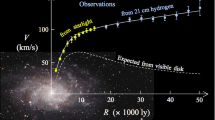Abstract
Chandrasekhar’s most important contribution to stellar dynamics was the concept of dynamical friction. I briefly review that work, then discuss some implications of Chandrasekhar’s theory of gravitational encounters for motion in galactic nuclei.
Similar content being viewed by others
References
T Padmanabhan, Curr. Sci. 70, 784 (1996)
S Chandrasekhar, The Astrophys. J. 97, 255 (1943)
S Chandrasekhar, Rev. Mod. Phys. 21, 383 (1949)
The integral for \(\mathcal{H}\) can be expressed exactly in terms of simple functions, although the expression is quite long. This is much easier to demonstrate nowadays than it was in the 1940s, with tools like Mathematica and Maple.
S Chandrasekhar and J von Neumann, The Astrophys. J. 95, 489 (1942)
R S Cohen, L Spitzer and P M Routly, Phys. Rev. 80, 230 (1950)
M L White, The Astrophys. J. 109, 159 (1949)
S Chandrasekhar, Principles of stellar dynamics (University of Chicago Press, Chicago, 1942)
M Maoz, Mon. Not. R. Astron. Soc. 263, 75 (1993)
M Milosavljević and D Merritt, The Astrophys. J. 563, 34 (2001)
P Côté et al, The Astrophys. J. 671, 1456 (2007)
R M Buchholz, R Schödel and A Eckart, Astron. Astrophys. 499, 483 (2009)
A W Graham, The Astrophys. J. Lett. 613, L33 (2004)
If so, then one might expect f to be somewhat anisotropic.
W A Mulder, Astron. Astrophys. 117, 9 (1983)
E P Lee, The Astrophys. J. 155, 687 (1969)
S Chandrasekhar, The mathematical theory of black holes (Clarendon Press, New York, 1983)
C Hopman and T Alexander, The Astrophys. J. 645, 1152 (2006)
K P Rauch and S Tremaine, New Astron. 1, 149 (1996)
S Gillessen, F Eisenhauer, S Trippe, T Alexander, R Genzel, F Martins and T Ott, The Astrophys. J. 692, 1075 (2009)
D Merritt, T Alexander, S Mikkola and C Will, Phys. Rev. D (in press); arXiv:1102.3180 (2011)
Author information
Authors and Affiliations
Corresponding author
Rights and permissions
About this article
Cite this article
MERRITT, D. Stellar dynamics and black holes. Pramana - J Phys 77, 135–146 (2011). https://doi.org/10.1007/s12043-011-0123-2
Published:
Issue Date:
DOI: https://doi.org/10.1007/s12043-011-0123-2




